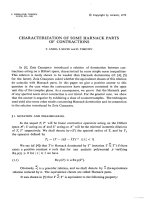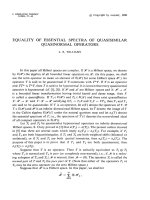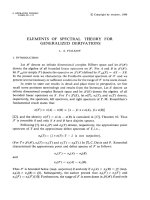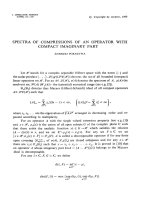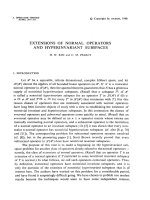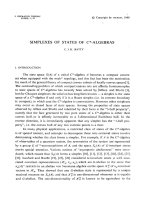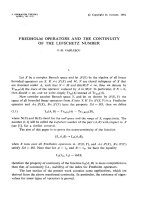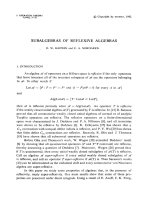Báo cáo toán học: " Deformation of Chains via a Local Symmetric Group Action" pot
Bạn đang xem bản rút gọn của tài liệu. Xem và tải ngay bản đầy đủ của tài liệu tại đây (178.14 KB, 18 trang )
Deformation of Chains via a Local Symmetric
Group Action
Patricia Hersh
∗
Department of Mathematics, Room 2-588
Massachusetts Institute of Technology
77 Massachusetts Avenue
Cambridge, MA 02139
Submitted: May 13, 1998; Accepted: March 3, 1999.
AMS Subject Classification: 05E25, 06A07.
Abstract
A symmetric group action on the maximal chains in a finite, ranked
poset is local if the adjacent transpositions act in such a way that
(i, i + 1) sends each maximal chain either to itself or to one differing
only at rank i.WeprovethatwhenS
n
acts locally on a lattice,
each orbit considered as a subposet is a product of chains. We also
show that all posets with local actions induced by labellings known
as R
∗
S-labellings have symmetric chain decompositions and provide
R
∗
S-labellings for the type B and D noncrossing partition lattices,
answering a question of Stanley.
1 Introduction
A symmetric group action on the maximal chains in a finite, ranked poset was
defined by Stanley in [St2] to be local if for each i, the adjacent transposition
s
i
=(i, i + 1) sends each maximal chain either to itself or to one differing
from it only at rank i.
∗
This work was supported by a Hertz Foundation Graduate Fellowship.
the electronic journal of combinatorics 6 (1999), #R27 2
There is a correspondence between rhombic tilings of a planar region and
equivalence classes of reduced expressions for a permutation up to commuta-
tion. This naturally translates symmetric group structure to poset structure
when S
n
acts locally on the maximal chains in a poset. We begin by re-
viewing this correspondence which is thoroughly examined in [El] because
we it will allow us to explain why orbits of local symmetric group actions on
lattices are always products of chains.
When a permutation w is written as a product of adjacent transpositions
w = s
a
1
s
a
2
s
a
l
with l as small as possible, such a product is called a
reduced expression for w. To obtain a rhombic tiling from this, begin with
a vertical path consisting of n + 1 nodes; as one reads off each successive
adjacent transposition s
a
i
in a reduced expression, draw a new node to the
right of the current node of rank a
i
, and attach this new node to the nodes
of rank a
i
± 1 in the current path to obtain a new path. The resulting
region is bounded on the left by the initial path, on the right by the final
path, and is tiled by quadrilaterals. These quadrilaterals may be replaced
by rhombi by appropriately adjusting line segment slopes. Two reduced
expressions differing only by commutation relations give rise to the same
rhombic tiling. Applying a braid relation s
i
s
i+1
s
i
= s
i+1
s
i
s
i+1
to a reduced
expression amounts to a substitution within a tiling as in Figure 1. Any two
Figure 1: The relation s
i
s
i+1
s
i
= s
i+1
s
i
s
i+1
in terms of tilings
reduced expressions for the same permutation give rise to rhombic tilings
which fit in exactly the same planar region. One may obtain any rhombic
tiling for a particular region from any other by applying braid relations.
We will use rhombic tilings to record how a maximal chain is deformed
under a local symmetric group action by successively applying the adjacent
transpositions in a reduced expression for a permutation. If p
2
= wp
1
,then
each reduced expression for w gives rise to a (potentially distinct) way of
deforming the maximal chain p
1
to p
2
within a poset. The structure of a
poset with a local symmetric group action must allow for all possible ways
the electronic journal of combinatorics 6 (1999), #R27 3
of deforming one maximal chain to another.
Each rhombic tiling may be viewed as the projection of a discrete 2-
dimensional surface S within a hypercube or multi-dimensional box onto a
generic plane. Such a surface S may be deformed via braid relations (as in
Figure 1) to surfaces coming from other reduced expressions for the same
permutation; relations of the form s
i
s
i+1
s
i
= s
i+1
s
i
s
i+1
will take surfaces
which include the front three faces of a cube to surfaces which instead includes
the back three faces. The surfaces given by the same permutation will have
the same boundary. The collection of rhombic tilings for a particular region
gives rise to all the minimal discrete surfaces within a multi-dimensional box
which have some fixed boundary. This point of view leads us to prove in
Section 2 that the maximal chains in an orbit of a local symmetric group
action must be arranged in such a way that they form the skeleton of such
a multi-dimensional box. Otherwise, braid relations would be violated or an
orbit would be incomplete (or both).
This does not, however, imply that each orbit is a product of chains
since the nodes in such a skeleton need not all be distinct. In Section 2, we
prove that the nodes are distinct when the poset is a lattice and conclude
that the orbits in lattices are products of chains. Sections 3 and 4 examine
local actions induced by labellings known as R
∗
S-labellings: in the former
section we prove that all posets with R
∗
S-labellings have symmetric chain
decompositions, while the latter provides R
∗
S-labellings for the interpolating
BD noncrossing partition lattices.
2 Orbit characterization
Simion and Stanley have shown in [SS] that the Frobenius characteristic of
a local symmetric group action on an orbit is always a complete symmetric
function. Theorem 3 will provide a more geometric proof of this result in
order to show how orbits are realized within posets. This will allow us to
characterize the orbits of local symmetric group actions on lattices in Theo-
rem 4, answering a question of Stanley.
Figure 2 gives an example of how the situation differs between posets and
lattices. Identifying the nodes labelled (0, 3) and (3, 0) within a product of
two 4-chains, yields a poset with a local symmetric group action with three
orbits. One orbit consists of the maximal chains from the original product
of chains before identification. Two new maximal chains are introduced, one
of which is depicted by the shaded lines in Figure 2. These maximal chains
due to crossover give rise to two trivial orbits.
the electronic journal of combinatorics 6 (1999), #R27 4
(0, 3)(3, 0)
(0, 0)
(3, 3)
Figure 2: A product of chains with node identification
This example depends on the fact that the above poset is not a lattice.
Definition 1. When the symmetric group acts locally on the maximal
chains in a poset, then the elements of an orbit subposet are the nodes in
any maximal chain within the orbit specifying it. The covering relations are
induced by covering relations from the maximal chains in the orbit.
In lattices, the maximal chains in an orbit subposet turn out to be exactly
the maximal chains belonging to the orbit specifying it.
Lemma 2 justifies geometric claims within the proof of Theorem 3.
Lemma 2. If s
i
(p) = p and s
i+1
(p)=p,thens
i+1
(s
i
(p)) = s
i
(p). Similarly,
if s
i+1
(p) = p and s
i
(p)=p,thens
i
(s
i+1
(p) = s
i+1
(p).
proof. If s
i+1
(s
i
(p)) = s
i
(p)ands
i+1
(p)=p,then
s
i
(p)=s
i+1
(s
i
(p))
= s
i+1
s
i
(s
i+1
(p))
= s
i
(s
i+1
(s
i
(p)))
= s
i
(s
i
(p))
= p.
The second assertion follows similarly.
In Theorem 3 we will define a map φ from maximal chains in a poset
to lattice paths in ZZ
n
. Lemma 2 implies that whenever im(φ) includes two
lattice paths involving segments abdf and acdf, (in Figure 3) respectively,
the electronic journal of combinatorics 6 (1999), #R27 5
and otherwise agreeing, then im(φ) will also include a lattice path through
acef which otherwise agrees with both these paths. No assumption is made
about whether bd is perpendicular or parallel to df.
c
e
f
d
a
b
Figure 3: Building an orbit
Theorem 3. If S
n
acts locally on the maximal chains in a poset, then the
Frobenius characteristic of the action is an h-positive symmetric function.
proof. We will prove that the local symmetric group action on any orbit is
isomorphic to a local action on some product of chains C
λ
1
+1
×···×C
λ
k
+1
,
since this action will have Frobenius characteristic h
λ
.
Let us refer to maximal chains in a poset P as P -chains. We claim that
anyorbitmaybeembeddedbyamapφ into the lattice ZZ
n
in such a way
that poset rank is encoded as sum of coordinates and P -chains are sent to
lattice paths within IN
n
. We will define φ in such a way that im(φ) will
be the collection of all minimal lattice paths from the origin to a particular
endpoint in IN
n
. Furthermore, s
i
will act nontrivially on a P -chain p whenever
the segment of the lattice path φ(p)fromranki−1toranki is perpendicular
to the segment from rank i to i + 1. When path segments are labelled by
lattice basis vectors, then applying an adjacent transposition will amount
to swapping a lattice path with one which has the two consecutive labels
swapped.
We define φ by choosing a P -chain p and specifying how to embed wp
into IN
n
for each w ∈ S
n
. The embedding will be based on a choice of
reduced expression for w, but we will check that all reduced expressions for
the same permutation w yield the same lattice path φ(wp). To conclude that
φ is well-defined, we will also need to show that φ(w
1
p)=φ(w
2
p) whenever
w
1
p = w
2
p, using the definition of local action.
If s
i
(p)=p for all i<a
1
and s
a
1
(p) = p, then let the lattice path φ(p)
beginwithasegmentfrom(0, ,0) to (a
1
, 0, ,0). The lattice path φ(p)
the electronic journal of combinatorics 6 (1999), #R27 6
will change direction at rank i for each i such that s
i
(p) = p. In particular, if
s
a
2
acts nontrivially on p and all intermediate s
i
act trivially on p,thenφ(p)
includes the segment from (a
1
, 0, ,0) to (a
1
,a
2
−a
1
, 0, ,0). At this point,
we may specify how φ(wp) is related to φ(p) for any w which only involves
the adjacent transpositions s
1
, ,s
a
2
−1
.Ifs
j
p
1
= p
2
= p
1
for a P -chain p
1
which has already been embedded up to rank j +1,thenp
2
is embedded up
to rank j+1 by replacing the node of rank j in φ(p
1
) with the only other node
of rank j in IN
n
which together with the rest of φ(p
1
) gives a lattice path. In
this way, the embedding of p up to rank a
2
locally gives rise to every possible
discrete path of minimal length from the origin to (a
1
,a
2
− a
1
, 0, ,0); first
one obtains φ(s
a
1
(p)), and repeated application of Lemma 2 yields all minimal
length lattice paths from (0, ,0) to (a
1
,a
2
−a
1
, 0, ,0). These paths may
be sequentially embedded in many different orders, but the commutation
relations s
i
s
j
= s
j
s
i
for |j − i|≥2 force all choices to be equivalent.
The direction in which to extend φ(p)toranka
2
+1 is determined by how
s
a
2
acts upon the P -chains with image under φ passing through the lattice
point (a
1
,a
2
− a
1
, 0, ,0) which also agree with φ(p)afterwards. Theedge
out of (a
1
,a
2
−a
1
, 0, ,0) in φ(p) needs to be perpendicular to exactly those
segments into (a
1
,a
2
− a
1
, 0, ,0) which belong to lattice paths which are
acted upon nontrivially by s
a
2
, and which also include the given segment out
of (a
1
,a
2
− a
1
, 0, ,0).
Lemma 2 implies that at each step of the embedding of p, the next seg-
ment of φ(p) should be perpendicular to all but at most one of the lattice
path edges leading into this new segment, so embedding is feasible. In this
fashion we may define φ(p). Each time φ(p) changes direction, we repeatedly
apply Lemma 2 just as we did at rank a
1
to obtain lattice paths of the form
φ(wp). The relations s
i
s
i+1
s
i
= s
i+1
s
i
s
i+1
imply that when three consecu-
tive segments of some φ(wp) are all perpendicular, six lattice paths result all
belonging to im(φ), and the restriction of these lattice paths to the interval
form the skeleton of a cube.
Repeated application of Lemma 2 and braid relations thus yields every
minimal lattice path from the origin to the endpoint of φ(p) as the image
of some P -chain, so φ will be onto. We need only show that any pair of
distinct lattice paths α, β ∈ im(φ) come from distinct P -chains to insure
that φ is well-defined. Let v
1
and v
2
be nodes in ZZ
n
where α and β first
differ. There must also exist lattice paths γ, γ
∈ im(φ) containing v
1
and
v
2
, respectively, which otherwise agree with each other. From the definition
of φ it follows that γ and γ
are the images of distinct P-chains q,q
which
satisfy q
= s
i
(q)fori = rank(v
1
). Hence, v
1
and v
2
must be the images of
distinct poset elements of rank i, implying α and β are the images of distinct
the electronic journal of combinatorics 6 (1999), #R27 7
P -chains, so φ is well-defined. Our definition of φ insures that φ is injective,
since φ(p) = φ(wp) whenever p = wp.
The local S
n
-action on the orbit is thus an action well-known to have
Frobenius characteristic h
λ
, as desired.
The argument we present next was gleaned from a more complicated
proof involving the correspondence between rhombic tilings and commutation
classes of reduced expressions for a permutation.
Theorem 4. If S
n
acts locally on a lattice, then each orbit is a product of
chains.
proof. We begin by proving that a poset obtained from a product of two
chains by identifying two of its nodes cannot be a lattice. After this, we
will show how to reduce the proof of the theorem to this case. We assume
throughout that there is no node identification at rank 1, because we dealt
with this possibility while proving φ was well-defined in Theorem 3.
Consider a product of two chains, each of which has rank r.Letus
identify a =(r, 0) with b =(0,r) and assume there is no node identification
below rank r. Suppose this poset is a lattice. We use induction on j to show
that (j, 1) ≤ a for all j<r. As the base case, observe that (0, 1) ≤ a since
a = b =(0,r). If (j, 1) ≤ (r, 0) for some j ≥ 0, then (j, 1) ∨ (j +1, 0) ≤ (r, 0)
for j +1 ≤ r.Since(j +1, 0) ≤ (j +1, 1) and (j, 1) ≤ (j +1, 1) and
rank (j +1, 1) = rank (j, 1) + 1, note that (j, 1) ∨ (j +1, 0) = (j +1, 1)
in the poset. The definition of join thus implies (j +1, 1) ≤ (r, 0) = a
whenever (j, 1) ≤ (r, 0) for j +1 ≤ r. By induction, (r − 2, 1) ≤ a,so
a ≥ (r − 2, 1) ∨ (r − 1, 0) = (r − 1, 1), a contradiction.
There is one somewhat subtle point to be addressed in the way we will
show a poset is not a lattice by restricting to some subposet and showing
this cannot be a lattice. When we assume a poset is a lattice, we need to
be careful about whether the join of two subposet elements also lies in the
subposet. In the above induction, we only deal with joins a ∨ b of rank one
more than the rank of a and b, so this must be the join of a and b in any
lattice containing the above as a subposet.
Now consider any product of chains with nodes a and b of rank r identified
and with no node identification below rank r. Choose a maximal chain p
1
through the node a and a maximal chain p
2
through b (before identification),
and then restrict attention to the nodes in some deformation of p
1
to p
2
.
We choose p
1
and p
2
so that the number of adjacent transpositions needed
to deform p
1
to p
2
is as small as possible. If we let a =(a
1
, ,a
k
)and
the electronic journal of combinatorics 6 (1999), #R27 8
b =(b
1
, ,b
k
), using the coordinates given by the product of chains struc-
ture, then p
1
and p
2
both contain the node (min (a
1
,b
1
), ,min (a
k
,b
k
))
and agree below this node. Furthermore, a minimal deformation will not
affect the nodes between
ˆ
0and(min(a
1
,b
1
), ,min (a
k
,b
k
)). The nodes
above (min (a
1
,b
1
), ,min (a
k
,b
k
)) which occur in a minimal deformation
will give rise to a product of two chains, but with a and b identified.
This last observation follows from the fact that the coordinates which in-
crease in travelling from (min (a
1
,b
1
), ,min (a
k
,b
k
)) to a along the maximal
chain p
1
are completely disjoint from the set of coordinates which increase
in p
2
between (min (a
1
,b
1
), ,min (a
k
,b
k
)) and b. An example is illustrated
in Figure 4. The product of two chains comes from interspersing steps in
the direction of p
1
with steps in the direction of p
2
, while travelling from
(min (a
1
,b
1
), ,min (a
k
,b
k
)) to (max (a
1
,b
1
), ,max(a
k
,b
k
))
(0, 0, 0, 0)
(2, 2, 0, 0) = a
b =(0, 0, 1, 3)
(2, 2, 1, 3)
p
1
p
2
Figure 4: A 2-dimensional surface within a 4-dimensional product of chains
If a and b are identified in any product of chains, they will thus also be
identified in a subposet which is a product of two chains, and so the original
poset will not be a lattice.
3 Symmetric boolean decomposition
In this section, we show that posets with R
∗
S-labellings have symmetric
chain decompositions which may be defined in terms of these labellings. The
notion of R
∗
S-labelling was introduced by Simion and Stanley in [SS]. A
chain-labelling of a poset is R
∗
if
ˆ
0 ≺ u
1
≺ ··· ≺ u
k
= u ≤ v implies there
is a unique extension of this chain to a saturated chain from
ˆ
0tov with
strictly increasing labels between u and v. If a chain-labelling λ induces a
local S
n
-action on the maximal chains of a poset, and the sequences labelling
the maximal chains are all distinct, then λ is an S-labelling; in this case, S
n
the electronic journal of combinatorics 6 (1999), #R27 9
acts on sequences of edge labels by permuting the order of the labels, and
this induces a local action on the maximal chains with corresponding labels.
An S-labelling which is also R
∗
is an R
∗
S-labelling.
In the following theorem, we make reference to the unique saturated chain
from u to v with increasing labels for any pair u ≤ v. Thisisnotwell-
defined for a chain-labelling which is not an edge labelling, but we establish
the following convention. When we refer to the unique increasing chain from
u to v, we first choose the increasing maximal chain from
ˆ
0tou,andthen
based on this choice we select the resulting increasing saturated chain from
u to v.
Theorem 5. If a finite, ranked poset admits an R
∗
S-labelling, then the
elements may be decomposed into a disjoint union of symmetrically placed
boolean lattices.
proof. We define a map φ from elements of a finite poset P to symmet-
rically placed boolean lattices in the poset and show that this map is a
decomposition. Let λ be an R
∗
S-labelling for a poset P of rank n.Foreach
v ∈ P , there are unique saturated chains
ˆ
0=u
0
≺ u
1
≺ ··· ≺ u
k
= v and
v = v
0
≺···≺v
l
=
ˆ
1 with strictly increasing labels. Since λ is an S-labelling,
there exist u and w such that
ˆ
0 ≤ u ≤ v ≤ w ≤
ˆ
1 and rank w = n− rank
u with u and w satisfy the following two conditions: first, the set of labels
on the unique rising chain from
ˆ
0tou isthesameasthesetoflabelsonthe
unique rising chain from w to
ˆ
1. Second, the set of labels on the rising chain
from u to v is disjoint from the set of labels on the rising chain from v to w;
each of these sets is also disjoint from the set of labels on the rising chains
from
ˆ
0tou and from w to
ˆ
1. This is possible by restricting S
n
to acting lo-
cally on the saturated chain from
ˆ
0tov and likewise on the saturated chain
from v to
ˆ
1toobtainnewsaturatedchainswithallcommonlabelsshifted
down to below u anduptoabovew. There is a symmetrically placed boolean
lattice B
u,w
on the interval from u to w. It consists of all nodes reached by
restricting S
n
to acting locally on the orbit within this interval (u, w)which
includes the increasing chain from u to w.Sinceλ is an R
∗
-labelling, u and
w are uniquely specified, and v ∈ B
u,w
,soletφ(v)=B
u,w
.
Note that if φ(v
1
)=B
u,w
and v
2
∈ B
u,w
,thenφ(v
2
)=B
u,w
, because
the unique increasing chains from
ˆ
0tov
2
and from v
2
to
ˆ
1maybeobtained
by taking a maximal chain which includes v
2
in addition to u and w since
v
2
belongs to B
u,w
, and then applying a sequence of adjacent transpositions
permuting the labels above v
2
and below v
2
separately. Hence, φ provides a
decomposition.
the electronic journal of combinatorics 6 (1999), #R27 10
Note that R
∗
S-labellings restrict to intervals, so Theorem 5 also applies
to all the intervals in posets with R
∗
S-labellings.
Corollary 6. If a finite, ranked poset admits an R
∗
S-labelling, then it has
a symmetric chain decomposition.
proof. Theorem 9 provides a decomposition into symmetrically placed
boolean lattices, and each of these has a symmetric chain decomposition.
One may find an explicit construction of a symmetric chain decomposition
for the boolean lattices in a survery article by Greene and Kleitman [GK],
and this article also gives original references (de Bruijn et al., Leeb).
Reiner gives symmetric chain decompositions for the type B and interpo-
lating BD noncrossing partition lattices in [Re], but his SCD’s for interpo-
lating BD noncrossing partition lattices are not an immediate consequence
of his recursively defined SCD for type B. In the next section we provide an
R
∗
S-labelling for the type B noncrossing partition lattice, and this is easily
shown to restrict to an R
∗
S-labelling for the interpolating BD noncrossing
partition lattices. Theorem 5 leads to Reiner’s symmetric chain decomposi-
tion for type B, and this restricts to an SCD for the other types since the
R
∗
S-labellings restrict to other types. One may similarly show that other
subposet of posets with R
∗
S-labellings have symmetric chain decompositions.
4 Noncrossing partitions of types B and D
Reiner defined and studied noncrossing partition lattices for the classical
reflection groups in [Re]. In this section, we define an R
∗
S-labelling for the
type B, D and interpolating BD noncrossing partition lattices, answering a
question raised by Stanley in [St3]. The labelling for type B restricts to one
for the other types. This R
∗
S-labelling is also closely related to the labelling
by parking functions for the traditional (type A) noncrossing partition lattice
given in [St3].
The type B noncrossing partition is a partition of ±1, ±2, ,±n satis-
fying the following two conditions. If one places 1, 2, ,n,−1, −2, ,−n
sequentially about a circle spacing the numbers evenly, and one draws straight
lines through the circle between any two numbers belonging to the same com-
ponent of a partition, then the interior of the circle should have 180 degree
rotational symmetry. Furthermore, deleting any two edges that cross should
leave the partition unchanged. By convention, the numbers are placed clock-
wise about the circle. For each component C
i
there will be a component −C
i
the electronic journal of combinatorics 6 (1999), #R27 11
such that j ∈ C
i
if and only if −j ∈−C
i
. In particular, one of the compo-
nents may satisfy C = −C. When such a component exists, this is called
the 0-component, denoted by C
0
. The noncrossing property precludes the
existence of more than one 0-component. The type B noncrossing partition
lattice is the poset of type B noncrossing partitions ordered by refinement.
The type D noncrossing partition lattice is the restriction to partitions with
C
0
= {±i} for 1 ≤ i ≤ n. The interpolating BD noncrossing partition lat-
tices arise by choosing a subset S ⊆{1, ,n} and forbidding partitions with
C
0
= {±i} for i ∈ S.
We define an edge-labelling λ for the type B noncrossing partition lattice
in terms of covering relations. If v is obtained from u by merging C with
−C to form C
0
,thenC is entirely contained in some semicircle S.Inthis
case, we let λ(u, v)=i where i ∈{1, ,n} and ±i is the last element of C
encountered while travelling clockwise about S.Ifv is obtained from u by
merging two components C
1
and C
2
(and simultaneously merging −C
1
with
−C
2
), then one of the following conditions is true (for some choice of which
component is C
1
and which is C
2
). Either there is some pair of elements both
in C
2
such that all elements of C
1
lie between these two elements of C
2
,or
there is some semicircle S which contains both C
1
and C
2
and such that all of
C
2
comes before all of C
1
travelling clockwise about S. In either case, there
is some i ∈{1, ,n} such that ±i is the last element of C
2
encountered
before the first clockwise element of C
1
,andthenweletλ(u, v)=i.
For example, listing only blocks with more than one element, the maxi-
mal chain
∅≺±{5, 6}≺±{5, 6}, {±4}≺±{1, 3}, ±{5, 6}, {±4}≺±{1, 2, 3}, ±{5, 6},
{±4}≺{±1, ±2, ±3, ±4}, ±{5, 6}≺{±1, ±2, ±3, ±4, ±5, ±6}
is labelled with the parking function λ =(5, 4, 1, 1, 4, 4). Figure 5 depicts
how components are sequentially merged in this maximal chain; arc labels
indicate the order in which components are merged.
We follow Stanley [St3] in referring to sequences in {1, ,n}
n
as type
B parking functions. The number of maximal chains in NC
B
(n)isn
n
,and
Theorem 7 will show that λ labels each maximal chain with a distinct type
B parking function.
Theorem 7. The labelling λ on the type B noncrossing partition lattice is
an R
∗
S-labelling.
proof. We prove that λ is a bijection between maximal chains and sequences
the electronic journal of combinatorics 6 (1999), #R27 12
1
4
−1
−4
3
2
5
6
−5
−6
−3
−2
4
3
5
2
1
6
4
3
5
1
6
Figure 5: A maximal chain in a type B noncrossing partition lattice
in {1, ,n}
n
by recursively defining the inverse map. After that, we verify
that the S
n
-action permuting the order of the digits in parking functions
induces a local action on corresponding maximal chains to conclude that λ
is an S-labelling. Finally, we check that λ is also an R
∗
-labelling.
It will suffice to provide the inverse to λ for those maximal chains in
which 1 is merged with some j ∈{2, ,n,−1} at rank 1. These chains
will be labelled by exactly those parking functions which have 1 as their
first digit. Symmetry will imply that for each i ∈{1, ,n} there is an
analogous bijection between maximal chains which have i merged with some
j ∈{i +1, ,n,1, ,−i} at rank 1 and type B parking functions with i
as their first digit.
Given a parking function with first digit 1, the choice of which j to merge
with 1 at rank 1 will depend on the content (but not the order) of the
remaining n − 1 digits in the parking function. In order to determine j,let
us rearrange the remaining parking function digits in increasing order and
view this weakly increasing sequence as a path from (1, 1) to (n, n)madeup
of steps up and steps to the right, each of length 1. If every lattice point in
this path is of the form (k, i)fori ≤ k,thenletj = −1. Otherwise, let j be
the unique integer such that (j +1,j) belongs to the lattice path and this
is the first place the path goes above the staircase path. (Lattice paths are
used in a similar fashion in [Re].)
Of the n − 1 digits specifying such a path, those which are less than j will
determine how elements between 1 and j −1 will be merged in the remainder
of the saturated chain while digits between j and n will determine how to
merge elements between j and −1 on the circle. Note that the former corre-
the electronic journal of combinatorics 6 (1999), #R27 13
spond to type A parking functions on 1, ,j− 2 while the latter correspond
to elements of [j, ,n]
n−j
. Hence, the n − 1 remaining digits give rise to a
type A parking function on 1, ,j − 2 interspersed with a type B parking
function on j, n.
There is a corresponding decomposition of the space of maximal chains
which recursively completes the bijection. This involves the following prod-
uct structure which is discussed in [Re], and which generalizes similar struc-
ture for type A as studied in [SU]. Let M
i
(NC
B
(n)) denote the collection
of maximal chains in the type B noncrossing partition lattice on ±1, ,±n
which begin by merging i ∈{1, ,n} with any j ∈{i +1, ,−i} and
merging −i with −j.LetM
i,j
(NC
B
(n)) denote the restriction to max-
imal chains with a particular choice of j.ObservethatM
i
(NC
B
(n)) =
j∈{i+1, ,−i}
M
i,j
(NC
B
(n)). Also note that the interval (u,
ˆ
1) from a type
B noncrossing partition u of rank 1 up to
ˆ
1 is isomorphic to NC
A
(j − i) ×
NC
B
(n − j + i)ifi is merged with j in u. Hence, maximal chains in such
an interval are labelled by type A parking functions interspersed with type
B parking functions, as desired.
To show that λ induces a local symmetric group action, we need to check
that the maximal chain labelled by the type B parking function (a
1
, ,a
n
)
differs only at rank i from the maximal chain labelled (a
1
, ,a
i+1
,a
i
, ,a
n
)
for a
i
= a
i+1
.Notethatλ
−1
“decides” which node to visit next at each
step in choosing a maximal chain from
ˆ
0to
ˆ
1 based only on the content of
the remaining digits. This implies that the two maximal chains will agree
up to rank i − 1. Also observe that merge steps i and i + 1 “commute”
for a
i
= a
i+1
by virtue of the recursively defined bijection λ.Thisnotion
of commutativity comes from treating merge steps as operators which take
poset elements of rank i − 1toonesofranki. Our discussion of edge-
labelled graphs immediately following this theorem should clarify this point.
The symmetric group relations are automatically satisfied since the action
on maximal chains is induced by a valid symmetric group action on the type
B parking functions which label them.
Finally, we claim that this S-labelling is also R
∗
. First note that the
unique rising chain from
ˆ
0to
ˆ
1 involves merging {1, ,i} with {i +1} at
stage i for 1 ≤ i<nand then merging {1, ,n} with {−1, ,−n} at
stage n.Foru ≤ v the increasing chain from u to v is found similarly, but
skipping steps merging components which are already merged in u or still
not merged in v.
One may associate graphs to orbits and edge labellings of these graphs
to maximal chains within each orbit to make the recursive structure explicit.
the electronic journal of combinatorics 6 (1999), #R27 14
Figure 5 is an example of such a graph. Begin with a circle with nodes
1, ,n,−1, ,−n placed sequentially about it. For each covering relation
u ≺ v in a maximal chain, we will draw a pair of arcs which are each labelled
with the rank of v. For convenience, we will refer to left and right endpoints
of arcs, by which we will mean the endpoint that appears to the left or right
from the point of view from the center of the circle. The absolute value
of the left endpoints of the pair of arcs labelled i will be the ith digit of
the parking function which labels our maximal chain. Labelling poset edges
with the absolute value of the right endpoints of the same arcs gives another
poset edge-labelling. This labelling restricts to an EL-labelling for the type
A noncrossing partition lattice; the type A labelling was defined by Bj¨orner
and was studied by Edelman and Simion in [ES]. Unfortunately, the type B
labelling is not also an EL-labelling. The type A analogue of edge-labelled
graphs are equivalent to the vertex-labelled trees discussed in [ES].
If C is merged with −C in the covering relation u ≺ v, recall that there
is some semicircle containing all of C. Draw an arc from i to −i where i is
the last element of C encountered travelling clockwise about this semicircle.
If C
1
is merged with C
2
and C
1
lies entirely between consecutive elements of
C
2
, then draw an arc with left endpoint at the element of C
2
which comes last
clockwise before reaching C
1
. The right endpoint will be the first element
of C
1
encountered continuing clockwise from this element of C
2
.Otherwise,
there is a semicircle which includes all of C
1
and all of C
2
. Draw an arc
connecting the nearest elements of C
1
and C
2
to each other.
These edge-labelled graphs always satisfy the following two conditions.
First, each point on the circle is the right endpoint to exactly one arc. Second,
the labels on the arcs with a particular left endpoint increase as one reads
away from the center of the circle, i.e. as the right endpoints of these arcs
progress counterclockwise.
Note that whenever two consecutive digits a
i
and a
i+1
in a parking func-
tion differ, the arcs labelled i and i + 1 will have different left endpoints, so
swapping these arc labels gives an edge-labelled graph which still satisfies the
above two conditions. Hence, the two maximal chains with parking functions
(a
1
, ,a
n
)and(a
1
, ,a
i+1
,a
i
, ,a
n
) have edge-labelled graphs with these
arc labels swapped, so the chains differ only at rank i. Successively applying
adjacent transpositions shows that maximal chains p and wp in the same
orbit give rise to the same underlying graph, but with arc-labels permuted
by w.
One may restrict R
∗
S-labellings to subposets by forbidding particular arcs
within these graphs. The interpolating BD noncrossing partition lattices are
an example of such a restriction.
the electronic journal of combinatorics 6 (1999), #R27 15
Theorem 8. The labelling λ restricts to an R
∗
S-labelling for the interpo-
lating BD noncrossing partition lattices.
proof. The maximal chains of type B which do not occur in a particular
interpolating BD noncrossing partition lattice constitute entire orbits. Hence
the restriction of the R
∗
S-labelling is still an S-labelling. An increasing chain
between two partitions which both satisfy C
0
= {±i} never involves merging
±i to form C
0
= {±i} at an intermediate step, so every remaining interval
still has a unique increasing chain.
Ehrenborg defined in [Eh] the function
F
P
=
ˆ
0=t
0
≤t
1
≤···≤t
k−1
<t
k
=
ˆ
1
x
ρ(t
0
,t
1
)
1
x
ρ(t
1
,t
2
)
2
···x
ρ(t
k−1
,t
k
)
k
which counts the chains in a finite, ranked poset P which include any partic-
ular collection of ranks. We use Theorem 8 to evaluate F
P
for interpolating
BD noncrossing partition lattices. Let φ
P
be the Frobenius characteristic of
the local symmetric group action induced by an R
∗
S-labelling of P . Simion
and Stanley proved in [SS] that F
P
= ωφ
P
,whereω is the symmetric function
involution which (in particular) swaps e
λ
with h
λ
.
In the following two corollaries, we sum over compositions of n, denoted
by α,whereα
i
counts the number of digits in a type B parking function
which are equal to i. Each composition accounts for a single orbit of the
symmetric group action on parking functions permuting positions.
Corollary 9. If P is the type B noncrossing partition lattice NC
B
(n),then
F
P
=
{α∈IN
n
|α
1
+···+α
n
=n}
e
α
.
proof. We invoke the theorem of Simion and Stanley that F
P
= ωφ
P
,with
φ
P
, as defined above. To obtain φ
P
, we sum Frobenius characteristic over
orbits. Each orbit is a product of chains and so has Frobenius characteristic
h
α
.
For example, if P = NC
B
(3) then F
P
= e
3
1
+6e
1
e
2
+3e
3
.
Corollary 10. If P is the interpolating BD noncrossing partition lattice
NC
BD
S
,then
F
P
=
{α∈IN
n
∩PF
S
|α
1
+···+α
n
=n}
e
α
the electronic journal of combinatorics 6 (1999), #R27 16
for PF
S
=
i∈S
{α|α
i
+ ···+ α
j
<j− i +1for some i ≤ j ≤ n or α
i
+ ···+
α
n
+ α
1
+ ···+ α
j
<j+ n − i +1for some j<i}.
proof. Theorem 8 implies NC
BD
S
(n) has an R
∗
S-labelling, so we again use
the fact that F
P
= ωφ
P
. Note that the type B orbits which survive are those
with edge-labelled graph not involving an arc from i to −i for any i ∈ S.
The definition of PF
S
allows the parking functions corresponding to exactly
these maximal chains.
For example, if P = NC
BD
S
(3) with S = {1},thenF
P
= e
3
1
+5e
1
e
2
+2e
3
.
This poset has two fewer orbits than NC
B
(3), since the orbits of NC
B
(3)
with label content (1, 1, 1) and (1, 1, 2) are no longer permitted.
In the specialization of Corollary 10 to type B, we have S = ∅,which
means {1, ,n}
n
∩ PF
S
= {1, ,n}
n
, and we recover Corollary 9. When
S = {1, ,n}, i.e. in the case of the type D specialization, we obtain F
P
=
a∈PF
{1, ,n}
e
α(a)
. Using recursive product structure, F
P
for type D may
alternatively be expressed as
F
NC
B
(n)
− n
T ⊆{3, ,n}
e
|T |+2
F
NC
A
(t
1
−2)
F
NC
A
(n−t
|T |
)
|T |−1
i=1
F
NC
A
(t
i+1
−t
i
)
.
Each of the subtracted sums comes from forbidding a particular 0-block
of the form {±i}. The edge-labelled graphs involving an arc from i to −i
also have arcs from i to i +1,soT specifies the right endpoints of all other
arcs with left endpoint i.WechooseT ⊆{3, ,n} above for the case i =1,
but the contribution to F
P
will be the same for any i, so we multiply by
n to consider all possible i ∈{1, ,n}.Thisn may be replaced by any
j ∈{1, ,n} to give a similar formula for an interpolating BD noncrossing
partition lattice with j = |S|.
Acknowledgments
The author thanks Richard Stanley for suggesting this area of study, and she
thanks him in addition to Clara Chan and Vic Reiner for helpful discussions
and encouragement. The author is also grateful to the anonymous referee for
very helpful advice about presentation.
References
[Bj] A. Bj¨orner. Shellable and Cohen-Macaulay partially ordered sets,Trans.
Amer. Math. Soc. 260 (1980), 159-183.
the electronic journal of combinatorics 6 (1999), #R27 17
[ES] P. Edelman and R. Simion. Chains in the lattice of noncrossing parti-
tons, Discrete Math. 126 (1994), 107-119.
[Eh] R. Ehrenborg. On posets and Hopf algebras, Advances in Math. 119
(1996), 1-25.
[El] S. Elnitsky. Rhombic tilings of polygons and classes of reduced words in
coxeter groups, Ph.D. thesis, Univ. of Mich., 1993.
[Fa] C.K. Fan. Structure of a Hecke algebra quotient, Jour. Amer. Math. Soc.
10 (1997) no. 1, 139-167.
[FR] D. Foata and J. Riordan. Mappings of acyclic and parking functions,
aequationes math. 10 (1974), 10-22.
[Gra] D. Grabiner. Posets in which every interval is a product of chains, and
a natural local action of the symmetric group, Discrete Math. 199,1-3
(1999), 77-84
[Gre] C. Greene. Posets of shuffles, J. Combin. Theory Ser. A 47 (1988),
191-206.
[GK] C. Greene and D. Kleitman. Proof techniques in the theory of finite sets,
in: G C. Rota (ed.), Studies in combinatorics, vol. 17 of MAA Studies
in Mathematics, 1978.
[Hu] J. Humphreys. Reflection Groups and Coxeter Groups, Cambridge
studies in advanced mathematics 29, Cambridge University Press, Cam-
bridge, 1990.
[Re] V. Reiner. Non-crossing partitions for classical reflection groups,Dis-
crete Math. 177 (1997), 195-222.
[SS] R. Simion. and R. Stanley. Flag-symmetry of the poset of shuffles and
a local action of the symmetric group, to appear in Discrete Math.
[SU] R. Simion. and D. Ulmann. On the structure of the lattice of non-
crossing partitions, Discrete Math. 98 (1991), 193-206.
[St1] R. Stanley. Enumerative Combinatorics, vol. I. Wadsworth and
Brooks/Cole, Pacific Grove, CA, 1986.
[St2] R. Stanley. Flag-symmetric and locally rank-symmetric partially ordered
sets, Electronic J. Combinatorics 3(2), R6 (1996), 22 pp.
the electronic journal of combinatorics 6 (1999), #R27 18
[St3] R. Stanley. Parking functions and noncrossing partitions, Electronic J.
Combinatorics 4(2), R20 (1997), 17 pp.
[Ve] A.M. Vershik. Local stationary algebras, Amer. Math. Soc. Transl. (2)
148 (1991), 1-13; translated from Proc. First Siberian Winter School “Al-
gebra and Analysis” (Kemerovo, 1988).


